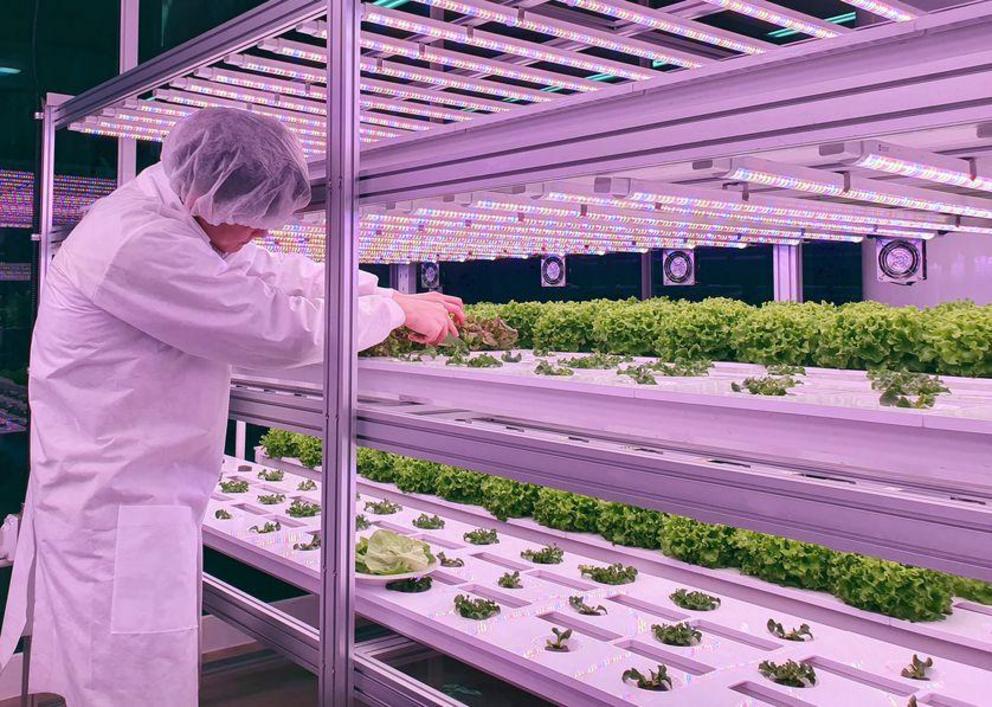Why the indoor farming movement is taking off
No soil. No sun. No problem.
As the world emerges from a pandemic that has kept about one in five people in their homes for weeks, it's little surprise that the idea of indoor farming is gaining traction. After all, we've had a lot of time to think about what we can do indoors — and maybe even ponder what we may have done outdoors that contributed to this mess.
You wouldn't think farming, one of humanity's oldest and most crucial endeavors, would be on that list. But as the number of mouths that need to be fed has grown, so too has the need for arable land. To meet that demand, industrial farming, with its reliance on large-scale, intensive production of crops and chemical fertilizers, has dramatically transformed much of the Earth's surface. Along the way, it has erased vital wildlife habitats, addled our atmosphere with greenhouse gases and undermined the health of communities living near those lands.
Indoor farming, on the other hand, isn't as land intensive. In fact, new technologies and advancements in hydroponics are making it possible to grow crops without pesticides, soil or even natural light. And since indoor crops can be stacked vertically, there's no need for vast tracts of land. Imagine farms as downtown office towers, offering floor after floor of fresh produce.
A recent study from the World Wildlife Fund confirms that indoor farming can save land and water. But it also identified a few hurdles. In the absence of sunlight, indoor operations have to rely on powerful artificial lights that use a lot of energy and produce so much heat that some indoor farms have to rely on air conditioning year-round. Ramping up the scale of those farms may only shift the burden from land to energy use — although, as the study notes, we can expect technology to improve energy efficiency.
In fact, the WWF puts so much stock in its potential, it's helping the city of St. Louis transform its network of abandoned caves into indoor farms.
Farming takes a bite out of wilderness
At first blush, it may seem like an unlikely partnership. What does an organization dedicated to wilderness preservation have to do with the development of farms? But part of the WWF's mandate is to find ways to reduce the environmental imprint of growing food, especially since vital habitats like forests are often cleared to make space for farmland.
"We're looking for new business models, new strategies and partnerships, and different ways of approaching things that are financially profitable as well as environmentally sustainable," Julia Kurnik, the WWF's director of innovation startups, tells Fast Company. "Our goal as an institute is to find things that can happen quickly and at scale, so that's why we're interested in making sure they can really take off and live beyond our investment."
 Advances in hydroponics and technology have made it possible to grow more of our food indoors.
Advances in hydroponics and technology have made it possible to grow more of our food indoors.
But will indoor crops — whether housed in sky-spanning towers or intricate caves — ever fully replace their outdoor counterparts as breadbasket to the world?
Probably not. Even vertical farms stacked as high as skyscrapers will eventually run into the same space constraints — unless, of course, we find a way to stack them to the moon. And we're just talking about a perfect vegetarian world here. No one is thinking about confining animals to caves and towers.
Besides, we're all relatively new to the trade. After all, humans don't have a lot of experience growing their food indoors like they do with traditional farming.
As investment banker Erik Kobayashi-Solomon writes in Forbes, "Humans have 12,000 years of experience growing food, but only a generation or so worth of experience growing crops indoors. We are still progressing up the technology learning curve, to the extent that there is a lack of good data about basic questions — comparing crop yields for plants grown outdoors in soil, inside a greenhouse, and indoors using hydroponics, for instance."
But indoor operations may be able to ease at least some of the pressure industrial farming puts on our sorely overtaxed Earth.
The grow-your-own food movement
The best part about an indoor farming revolution may be that it's already begun — with individuals. The lockdown has seen a massive surge in the grow-your-own food movement, as people look not only for something to do with their time but also reduce their reliance on grocery stores.
(A shame we still haven't found a way to grow our own toilet paper.)
In the U.S., as Mashable reports, garden centers and seed delivery services have seen sales grow 10-fold during the pandemic, with Walmart selling out of seeds completely.
There's much breathless enthusiasm, and understandable optimism, to the indoor movement as people look to do things a little differently in the post-pandemic era.
"Thanks to giant leaps forward in the science of hydroponics and LED lighting, even people in windowless, gardenless apartments can participate in the revolution," writes Chris Taylor in Mashable. "With a number of high-tech consumer products on the way, the process can be automated for those of us without green thumbs."
And some farmers, like Benjamin Widmar, didn't need a pandemic to be the change he wanted to see. He's trying to grow enough tomatoes, onions, chillies and microgreens to meet an entire town's needs. All from his indoor farm in Norway's Svalbard archipelago, about 650 miles south of the North Pole.
"We're on a mission … to make this town very sustainable," he tells the Thomson Reuters Foundation. "Because if we can do it here, then what's everybody else's excuse?"
Take a tour of Widmar's operation in the video below:

